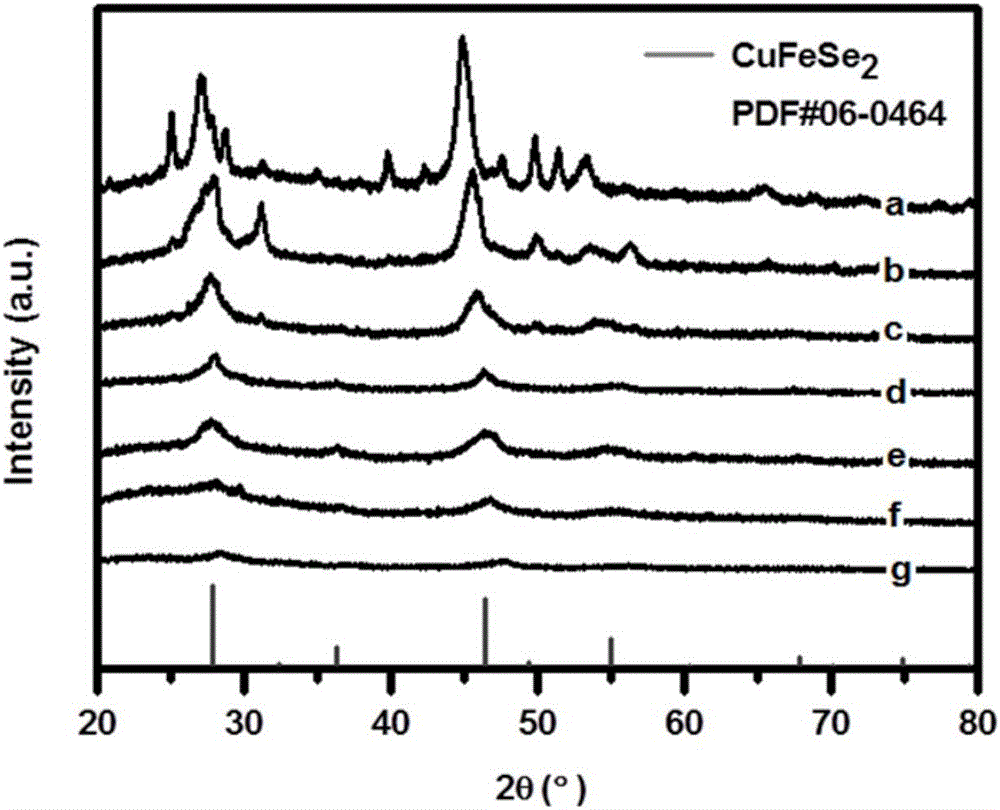Bi-metal sulfur group ternary semiconductor nanoparticle and preparation method thereof
A nanoparticle and semiconductor technology, applied in the field of biomedicine, can solve the problems of few reports of bimetallic chalcogenide ternary semiconductor nanomaterials, poor water solubility and biocompatibility, and complicated preparation process, and achieves easy promotion and uniform particle size. , the effect of simple operation
- Summary
- Abstract
- Description
- Claims
- Application Information
AI Technical Summary
Problems solved by technology
Method used
Image
Examples
Embodiment 1
[0049] After passing 100mL of ultrapure water through nitrogen to remove oxygen, weigh sodium borohydride (2.27g, 60mmol) and add it to the anaerobic water to dissolve completely, then add selenium powder (1.57g, 20mmol), the molar ratio of sodium borohydride to selenium 3:1, after the selenium powder reacts completely, dissolve 5mL of CuCl 2 2H 2 O and FeSO 4 ·7H 2 O (the total molar weight of the two is 20mmol, the addition ratio is nFe / n(Cu+Fe)=0.2(b), 0.4(c), 0.5(d), 0.6(e), 0.8(f), single CuCl 2 2H 2 O, single FeSO 4 ·7H 2 O (g)) aqueous solution is injected into the selenium precursor, and the solution turns black immediately, is centrifuged and washed, and vacuum-dried to obtain a black powder. The X-ray diffraction (XRD) of the obtained copper-iron-selenium semiconductor nanoparticles is shown in figure 1 . from figure 1 It can be seen that the resulting CuFeSe 2 (d) Diffraction peaks of nanoparticles and CuFeSe 2 -XRD standard cards are consistent, and the d...
Embodiment 2
[0051] After passing 100mL of ultrapure water through nitrogen to remove oxygen, weigh sodium borohydride (2.27g, 60mmol) and add it to the anaerobic water to dissolve completely, then add selenium simple substance (1.57g, 20mmol), the molar ratio of sodium borohydride to selenium simple substance 3:1, after the selenium powder reacts completely, dissolve 5mL of CuCl 2 2H 2 O (1.70mg, 10mmol) and NiCl 2 ·6H 2 The aqueous solution of O (2.38g, 10mmol) was injected into the selenium precursor solution, and the solution immediately turned black. After centrifugal washing and vacuum drying, a black powder was obtained, and the obtained copper-nickel-selenide semiconductor nanoparticles Cu 2-x Ni x Se 2 (x=0-1) X-ray diffraction (XRD) see figure 2 . from figure 2 It can be seen that the diffraction peaks of the obtained CuNiSe semiconductor nanoparticles are in the Cu 2-x In the middle of the standard cards for Se and NiSe-XRD.
Embodiment 3
[0053] After 100mL of ultrapure water is passed through nitrogen to remove oxygen, take sodium borohydride (2.27g, 60mmol) and add it to dissolve completely in this anaerobic water, add selenium simple substance 1.57g (20mmol), the mol ratio of sodium borohydride and selenium simple substance is 3:1, after the reaction of selenium powder is complete, dissolve 5mL of CuCl 2 2H 2 O (1.70g, 10mmol) and GaNO 3 9H 2 The aqueous solution of O (1.18g, 10mmol) is injected in the selenium precursor, and the solution turns dark brown immediately, centrifuges and washes after reaction 40min, and vacuum-dries to obtain black powder, the X-ray diffraction (XRD) of the copper gallium selenium semiconductor nanoparticle that obtains )See image 3 . It can be seen from the figure that the diffraction peaks of the obtained CuGaSe semiconductor nanoparticles are similar to those of CuGaSe 2 - The standard card of XRD is the same. Figure 4 For the resulting CuGaSe 2 From the X-ray photoe...
PUM
 Login to View More
Login to View More Abstract
Description
Claims
Application Information
 Login to View More
Login to View More - R&D
- Intellectual Property
- Life Sciences
- Materials
- Tech Scout
- Unparalleled Data Quality
- Higher Quality Content
- 60% Fewer Hallucinations
Browse by: Latest US Patents, China's latest patents, Technical Efficacy Thesaurus, Application Domain, Technology Topic, Popular Technical Reports.
© 2025 PatSnap. All rights reserved.Legal|Privacy policy|Modern Slavery Act Transparency Statement|Sitemap|About US| Contact US: help@patsnap.com



